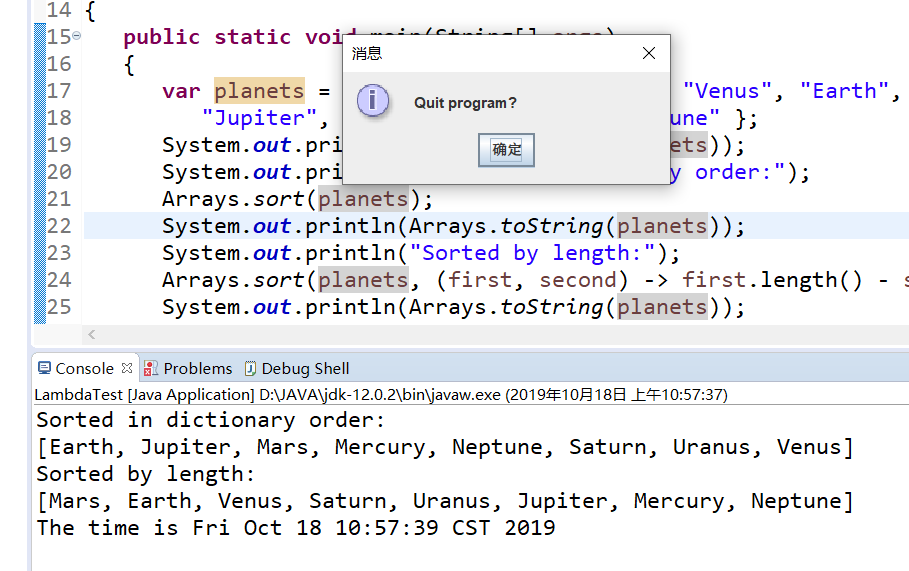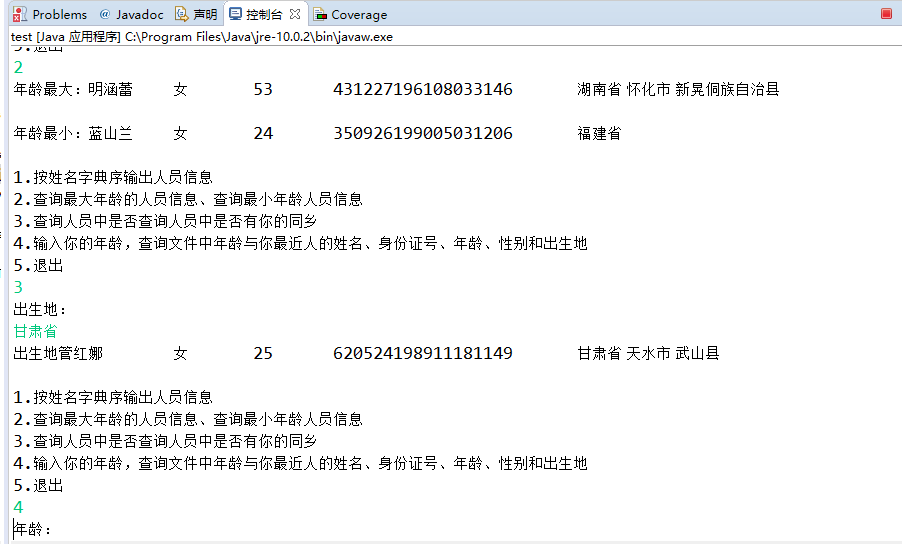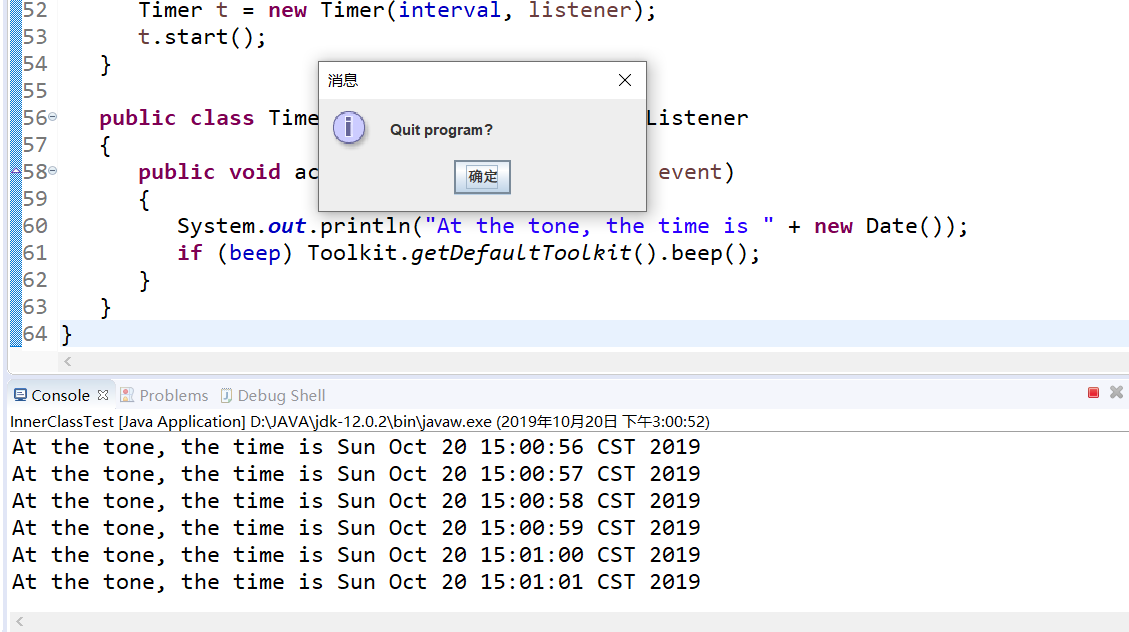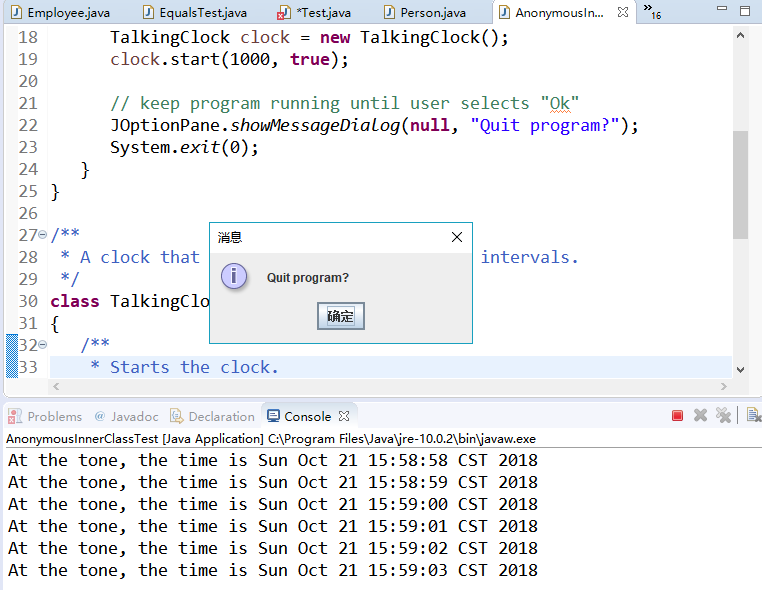201871010133-赵永军《面向对象程序设计(java)》第八周学习总结
201871010133-赵永军《面向对象程序设计(java)》第八周学习总结
| 项目 | 内容 |
| 这个作业属于哪个课程 | https://www.cnblogs.com/nwnu-daizh/ |
| 这个作业的要求在哪里 | https://www.cnblogs.com/nwnu-daizh/p/11703678.html |
| 作业学习目标 |
|
第一部分:总结第六章理论知识
1. 接口
1) Java为了克服单继承的缺点,Java使用了接口, 一个类可以实现一个或多个接口。
2) 在Java程序设计语言中,接口不是类,而是对类 的一组需求描述,由常量和一组抽象方法组成。
3) 接口中不包括变量和有具体实现的方法。
4) 只要类实现了接口,则该类要遵从接口描述的统 一格式进行定义,并且可以在任何需要该接口的 地方使用这个类的对象。
5)声明方式: public interface 接口名 { …… } 接口体中包含常量定义和方法定义,接口中只进 行方法的声明,不提供方法的实现。
6)类似建立类的继承关系,接口也可以扩展。 接口的扩展技术使得从具有较高通用性的接口存在 多条链延伸到具有较高专用性的接口。
扩展方法: public interface 接口1 extends接口2 { …… }
7)在类声明时用implements关键字声明使用一个或 多个接口
class Employee implementsPrintable { …… }
一个类使用了某个接口,那么这个类必须实现该 接口的所有方法,即为这些方法提供方法体。 一个类可以实现多个接口,接口间应该用逗号分 隔开。
class Employee implements Cloneable,Comparable
8)接口不能构造接口对象,但可以声明接口变量以指向一个实现了该接口的类对象。
Comparablex = new Comparable(…); //ERROR
Comparable x= new Employee(…); //OK
可以用instanceof检查对象是否实现了某个接口。
if (anObjectinstanceofComparable) { ……}
2. 接口与抽象类的区别:
(1)接口不能实现任何方法,而抽象类可以。
(2)类可以实现许多接口,但只有一个父类。
(3)接口不是类分级结构的一部分,无任何联系的类可以实现相同的接口。
3. 回调(callback):一种程序设计模式,在这种模式中,可指出某个特定事件发生时程序应该采取的动作。 在java.swing包中有一个Timer类,可以使用它在到达给定的时间间隔时触发一个事件。
Timer(intinterval, ActionListenerlistener)
void start()
void stop()
4. Object类的Clone方法
1)当拷贝一个对象变量时,原始变量与拷贝变量引用同一个对象。这样,改变一个变量所引用 的对象会对另一个变量产生影响。
2)如果要创建一个对象新的copy,它的最初状态与 original一样,但以后可以各自改变状态,就需要使用Object类的clone方法。
5. 浅层拷贝:被拷贝对象的所有常量成员和基本类 型属性都有与原来对象相同的拷贝值,而若成员域是一个对象,则被拷贝对象该对象域的对象引 用仍然指向原来的对象。
深层拷贝:被拷贝对象的所有成员域都含有与原 来对象相同的值,且对象域将指向被复制过的新对 象,而不是原有对象被引用的对象。换言之,深 层拷贝将拷贝对象内引用的对象也拷贝一遍。
6. Java Lambda 表达式是Java 8 引入的一个新的功能,主要用途是提供一个函数化的语法来简化编码。 Lambda表达式本质上是一个匿名方法。
public intadd(intx, inty) { return x + y; } 转成Lambda表达式后是: (intx, inty) -> x + y;
7.内部类(inner class)是定义在一个类内部的类。 外层的类成为外部类(outer class).
内部类主要用于事件处理。 使用内部类的原因有以下三个:
1)内部类方法可以访问该类定义所在的作用域中的数据,包括私有数据。
2)内部类能够隐藏起来,不为同一包中的其他类所见。
3)想要定义一个回调函数且不想编写大量代码时, 使用匿名内部类比较便捷。
第二部分:实验部分
1、实验目的与要求
(1) 掌握接口定义方法;
(2) 掌握实现接口类的定义要求;
(3) 掌握实现了接口类的使用要求;
(4) 掌握程序回调设计模式;
(5) 掌握Comparator接口用法;
(6) 掌握对象浅层拷贝与深层拷贝方法;
(7) 掌握Lambda表达式语法;
(8) 了解内部类的用途及语法要求。
2、实验内容和步骤
实验1: 导入第6章示例程序,测试程序并进行代码注释。
测试程序1:
1)编辑、编译、调试运行阅读教材214页-215页程序6-1、6-2,理解程序并分析程序运行结果;
2)在程序中相关代码处添加新知识的注释。
3)掌握接口的实现用法;
4)掌握内置接口Compareable的用法。
实验程序如下:
import java.util.*; /**
* This program demonstrates the use of the Comparable interface.
* @version 1.30 2004-02-27
* @author Cay Horstmann
*/
public class EmployeeSortTest
{
public static void main(String[] args)
{
Employee[] staff = new Employee[3]; staff[0] = new Employee("Harry Hacker", 35000);
staff[1] = new Employee("Carl Cracker", 75000);
staff[2] = new Employee("Tony Tester", 38000); Arrays.sort(staff);//调用Arrays类的sort方法(只有被static方法修饰了才可以这样调用) //输出所有employee对象的信息
for (Employee e : staff)
System.out.println("name=" + e.getName() + ",salary=" + e.getSalary());
}
}
用户自定义模块:
public class Employee implements Comparable<Employee>//实现接口类
{
private String name;
private double salary; public Employee(String name, double salary)
{
this.name = name;
this.salary = salary;
} public String getName()
{
return name;
} public double getSalary()
{
return salary;
} public void raiseSalary(double byPercent)
{
double raise = salary * byPercent / 100;
salary += raise;
} /**
* Compares employees by salary
* @param other another Employee object
* @return a negative value if this employee has a lower salary than
* otherObject, 0 if the salaries are the same, a positive value otherwise
*/
public int compareTo(Employee other)//比较Employee与其他对象的大小
{
return Double.compare(salary, other.salary);//调用double的compare方法
}
}
程序运行结果如下:

测试程序2:
l 编辑、编译、调试以下程序,结合程序运行结果理解程序;
|
interface A { double g=9.8; void show( ); } class C implements A { public void show( ) {System.out.println("g="+g);} }
class InterfaceTest { public static void main(String[ ] args) { A a=new C( ); a.show( ); System.out.println("g="+C.g); } } |
实验程序如下:
interface A//接口A
{
double g=9.8;
void show( );
}
class C implements A//C实现接口A
{
public void show( )
{System.out.println("g="+g);}
}
class InterfaceTest
{
public static void main(String[ ] args)
{
A a=new C( );
a.show( );
System.out.println("g="+C.g);//C实现了接口A,所以可以用C调用A中的变量
}
}
程序运行结果如下:

测试程序3:
1)在elipse IDE中调试运行教材223页6-3,结合程序运行结果理解程序;
2)26行、36行代码参阅224页,详细内容涉及教材12章。
3)在程序中相关代码处添加新知识的注释。
4)掌握回调程序设计模式;
实验程序如下:
/**
@version 1.01 2015-05-12
@author Cay Horstmann
*/ import java.awt.*;
import java.awt.event.*;
import java.util.*;
import javax.swing.*;
import javax.swing.Timer;
// to resolve conflict with java.util.Timer public class TimerTest
{
public static void main(String[] args)
{
ActionListener listener = new TimePrinter();//实现ActionListener类接口 //创建一个名为listener的timer数组
// 每十秒钟一次
Timer t = new Timer(10000, listener);//生成内置类对象
t.start();//调用t中的start方法 JOptionPane.showMessageDialog(null, "Quit program?");//窗口显示信息“Quit program?”
System.exit(0);
}
} class TimePrinter implements ActionListener//用户自定义类:实现接口
{
public void actionPerformed(ActionEvent event)
{
System.out.println("At the tone, the time is " + new Date());
Toolkit.getDefaultToolkit().beep();//返回Toolkit方法,借助Toolkit对象控制响铃
}
}
程序测试结果如下:

测试程序4:
1)调试运行教材229页-231页程序6-4、6-5,结合程序运行结果理解程序;
2)在程序中相关代码处添加新知识的注释。
3)掌握对象克隆实现技术;
4)掌握浅拷贝和深拷贝的差别。
实验程序如下:
import java.util.Date;
import java.util.GregorianCalendar; public class Employee implements Cloneable
{
private String name;
private double salary;
private Date hireDay; public Employee(String name, double salary)
{
this.name = name;
this.salary = salary;
hireDay = new Date();
} public Employee clone() throws CloneNotSupportedException
{
// 调用对象克隆
Employee cloned = (Employee) super.clone(); // 克隆易变字段
cloned.hireDay = (Date) hireDay.clone(); return cloned;
}//可能产生异常,放在try子句中 /**
* Set the hire day to a given date.
* @param year the year of the hire day
* @param month the month of the hire day
* @param day the day of the hire day
*/
public void setHireDay(int year, int month, int day)
{
Date newHireDay = new GregorianCalendar(year, month - 1, day).getTime(); // 实例字段突变
hireDay.setTime(newHireDay.getTime());
} public void raiseSalary(double byPercent)
{
double raise = salary * byPercent / 100;
salary += raise;
} public String toString()
{
return "Employee[name=" + name + ",salary=" + salary + ",hireDay=" + hireDay + "]";
}
}
程序测试结果如下:

实验2: 导入第6章示例程序6-6,学习Lambda表达式用法。
1)调试运行教材233页-234页程序6-6,结合程序运行结果理解程序;
2)在程序中相关代码处添加新知识的注释。
3)将27-29行代码与教材223页程序对比,将27-29行代码与此程序对比,体会Lambda表达式的优点。
实验程序如下:
import java.util.*; import javax.swing.*;
import javax.swing.Timer; /**
* This program demonstrates the use of lambda expressions.
* @version 1.0 2015-05-12
* @author Cay Horstmann
*/
public class LambdaTest
{
public static void main(String[] args)
{
String[] planets = new String[] { "Mercury", "Venus", "Earth", "Mars",
"Jupiter", "Saturn", "Uranus", "Neptune" };
System.out.println(Arrays.toString(planets));
System.out.println("Sorted in dictionary order:");
Arrays.sort(planets);//调用Arrays类的sort方法
System.out.println(Arrays.toString(planets));
System.out.println("Sorted by length:");
Arrays.sort(planets, (first, second) -> first.length() - second.length());//lambda表达式
System.out.println(Arrays.toString(planets)); Timer t = new Timer(1000, event ->
System.out.println("The time is " + new Date()));
t.start(); // keep program running until user selects "Ok"
JOptionPane.showMessageDialog(null, "Quit program?");//窗口显示信息“Quit program?”
System.exit(0);
}
}
程序运行结果如下:

注:以下实验课后完成
实验3: 编程练习
1)编制一个程序,将身份证号.txt 中的信息读入到内存中;
2)按姓名字典序输出人员信息;
3)查询最大年龄的人员信息;
4)查询最小年龄人员信息;
5)输入你的年龄,查询身份证号.txt中年龄与你最近人的姓名、身份证号、年龄、性别和出生地;
6)查询人员中是否有你的同乡
实验代码如下:
import java.io.BufferedReader;
import java.io.File;
import java.io.FileInputStream;
import java.io.FileNotFoundException;
import java.io.IOException;
import java.io.InputStreamReader;
import java.util.ArrayList;
import java.util.Arrays;
import java.util.Collections;
import java.util.Scanner; public class Test{ private static ArrayList<Person> Personlist1;
public static void main(String[] args) { Personlist1 = new ArrayList<>(); Scanner scanner = new Scanner(System.in);
File file = new File("C:\\Users\\lenovo\\Documents\\身份证"); try {
FileInputStream F = new FileInputStream(file);
BufferedReader in = new BufferedReader(new InputStreamReader(F));
String temp = null;
while ((temp = in.readLine()) != null) { Scanner linescanner = new Scanner(temp); linescanner.useDelimiter(" ");
String name = linescanner.next();
String id = linescanner.next();
String sex = linescanner.next();
String age = linescanner.next();
String place =linescanner.nextLine();
Person Person = new Person();
Person.setname(name);
Person.setid(id);
Person.setsex(sex);
int a = Integer.parseInt(age);
Person.setage(a);
Person.setbirthplace(place);
Personlist1.add(Person); }
} catch (FileNotFoundException e) {
System.out.println("查找不到信息");
e.printStackTrace();
} catch (IOException e) {
System.out.println("信息读取有误");
e.printStackTrace();
}
boolean isTrue = true;
while (isTrue) {
System.out.println("1:按姓名字典序输出人员信息;");
System.out.println("2:查询最大年龄与最小年龄人员信息;");
System.out.println("3.输入你的年龄,查询身份证号.txt中年龄与你最近人的姓名、身份证号、年龄、性别和出生地");
System.out.println("4:按省份找你的同乡;");
System.out.println("5:退出");
int type = scanner.nextInt();
switch (type) {
case 1:
Collections.sort(Personlist1);
System.out.println(Personlist1.toString());
break;
case 2: int max=0,min=100;int j,k1 = 0,k2=0;
for(int i=1;i<Personlist1.size();i++)
{
j=Personlist1.get(i).getage();
if(j>max)
{
max=j;
k1=i;
}
if(j<min)
{
min=j;
k2=i;
} }
System.out.println("年龄最大:"+Personlist1.get(k1));
System.out.println("年龄最小:"+Personlist1.get(k2));
break;
case 3:
System.out.println("place?");
String find = scanner.next();
String place=find.substring(0,3);
String place2=find.substring(0,3);
for (int i = 0; i <Personlist1.size(); i++)
{
if(Personlist1.get(i).getbirthplace().substring(1,4).equals(place))
{
System.out.println("你的同乡:"+Personlist1.get(i));
}
} break;
case 4:
System.out.println("年龄:");
int yourage = scanner.nextInt();
int close=ageclose(yourage);
int d_value=yourage-Personlist1.get(close).getage();
System.out.println(""+Personlist1.get(close)); break;
case 5:
isTrue = false;
System.out.println("再见!");
break;
default:
System.out.println("输入有误");
}
}
}
public static int ageclose(int age) {
int m=0;
int max=53;
int d_value=0;
int k=0;
for (int i = 0; i < Personlist1.size(); i++)
{
d_value=Personlist1.get(i).getage()-age;
if(d_value<0) d_value=-d_value;
if (d_value<max)
{
max=d_value;
k=i;
} } return k; }
}
1 public class Person implements Comparable<Person> {
private String name;
private String id;
private int age;
private String sex;
private String birthplace;
public String getname() {
return name;
}
public void setname(String name) {
this.name = name;
}
public String getid() {
return id;
}
public void setid(String id) {
this.id= id;
}
public int getage() {
return age;
}
public void setage(int age) {
// int a = Integer.parseInt(age);
this.age= age;
}
public String getsex() {
return sex;
}
public void setsex(String sex) {
this.sex= sex;
}
public String getbirthplace() {
return birthplace;
}
public void setbirthplace(String birthplace) {
this.birthplace= birthplace;
}
public int compareTo(Person o) {
return this.name.compareTo(o.getname());
}
public String toString() {
return name+"\t"+sex+"\t"+age+"\t"+id+"\t";
}
}
程序运行结果如下:


实验4:内部类语法验证实验
实验程序1:
1)编辑、调试运行教材246页-247页程序6-7,结合程序运行结果理解程序;
2)了解内部类的基本用法。
实验程序如下:
import java.awt.*;
import java.awt.event.*;
import java.util.*;
import javax.swing.*;
import javax.swing.Timer; /**
* This program demonstrates the use of inner classes.
* @version 1.11 2015-05-12
* @author Cay Horstmann
*/
public class InnerClassTest
{
public static void main(String[] args)
{
TalkingClock clock = new TalkingClock(1000, true);
clock.start(); // keep program running until user selects "Ok"
JOptionPane.showMessageDialog(null, "Quit program?");
System.exit(0);
}
} /**
* A clock that prints the time in regular intervals.
*/
class TalkingClock
{
private int interval;
private boolean beep; /**
* Constructs a talking clock
* @param interval the interval between messages (in milliseconds)
* @param beep true if the clock should beep
*/
public TalkingClock(int interval, boolean beep)
{
this.interval = interval;
this.beep = beep;
} /**
* Starts the clock.
*/
public void start()
{
ActionListener listener = new TimePrinter();
Timer t = new Timer(interval, listener);
t.start();
} public class TimePrinter implements ActionListener
{
public void actionPerformed(ActionEvent event)
{
System.out.println("At the tone, the time is " + new Date());
if (beep) Toolkit.getDefaultToolkit().beep();
}
}
}
程序运行结果如下:

实验程序2:
1)编辑、调试运行教材254页程序6-8,结合程序运行结果理解程序;
2)掌握匿名内部类的用法。
实验程序如下:
import java.awt.*;
import java.awt.event.*;
import java.util.*;
import javax.swing.*;
import javax.swing.Timer; /**
* This program demonstrates anonymous inner classes.
* @version 1.11 2015-05-12
* @author Cay Horstmann
*/
public class AnonymousInnerClassTest
{
public static void main(String[] args)
{
TalkingClock clock = new TalkingClock();
clock.start(1000, true); // keep program running until user selects "Ok"
JOptionPane.showMessageDialog(null, "Quit program?");
System.exit(0);
}
} /**
* A clock that prints the time in regular intervals.
*/
class TalkingClock
{
/**
* Starts the clock.
* @param interval the interval between messages (in milliseconds)
* @param beep true if the clock should beep
*/
public void start(int interval, boolean beep)
{
ActionListener listener = new ActionListener()
{
public void actionPerformed(ActionEvent event)
{
System.out.println("At the tone, the time is " + new Date());
if (beep) Toolkit.getDefaultToolkit().beep();
}
};
Timer t = new Timer(interval, listener);
t.start();
}
}
程序运行结果如下;

实验程序3:
1)在elipse IDE中调试运行教材257页-258页程序6-9,结合程序运行结果理解程序;
2)了解静态内部类的用法。
实验程序如下:
/**
* This program demonstrates the use of static inner classes.
* @version 1.02 2015-05-12
* @author Cay Horstmann
*/
public class StaticInnerClassTest
{
public static void main(String[] args)
{
double[] d = new double[20];
for (int i = 0; i < d.length; i++)
d[i] = 100 * Math.random();
ArrayAlg.Pair p = ArrayAlg.minmax(d);
System.out.println("min = " + p.getFirst());
System.out.println("max = " + p.getSecond());
}
} class ArrayAlg
{
/**
* A pair of floating-point numbers
*/
public static class Pair
{
private double first;
private double second; /**
* Constructs a pair from two floating-point numbers
* @param f the first number
* @param s the second number
*/
public Pair(double f, double s)
{
first = f;
second = s;
} /**
* Returns the first number of the pair
* @return the first number
*/
public double getFirst()
{
return first;
} /**
* Returns the second number of the pair
* @return the second number
*/
public double getSecond()
{
return second;
}
} /**
* Computes both the minimum and the maximum of an array
* @param values an array of floating-point numbers
* @return a pair whose first element is the minimum and whose second element
* is the maximum
*/
public static Pair minmax(double[] values)
{
double min = Double.POSITIVE_INFINITY;
double max = Double.NEGATIVE_INFINITY;
for (double v : values)
{
if (min > v) min = v;
if (max < v) max = v;
}
return new Pair(min, max);
}
}
程序运行结果如下:

第三部分;实验总结
在本周的学习过程中,主要了解了接口,接口和继承在某些方面比较相似,但是接口又在继承的基础上发展了一些优点,克服了java单继承的缺点。在学习过程中,可能是因为接口并不是具体的类,它只是实现,所以感觉接口比继承抽象一些,不太容易理解。但通过这周的学习以及实验中对具体程序的运行,对接口有了一定的掌握。自己编写饰演的过程中,在之前的基础上有的接口等新内容,自己还是不能独立完成,在同学的帮助下才勉强完成了实验。在实验课上老师讲的克隆以及函数接口等,自己还没有太掌握,在之后的学习中,一定会继续深入学习。
201871010133-赵永军《面向对象程序设计(java)》第八周学习总结的更多相关文章
- 201771010134杨其菊《面向对象程序设计java》第九周学习总结
第九周学习总结 第一部分:理论知识 异常.断言和调试.日志 1.捕获 ...
- 扎西平措 201571030332《面向对象程序设计 Java 》第一周学习总结
<面向对象程序设计(java)>第一周学习总结 正文开头: 项目 内容 这个作业属于哪个课程 https://www.cnblogs.com/nwnu-daizh/ 这个作业的要求在哪里 ...
- 201871010132-张潇潇《面向对象程序设计(java)》第一周学习总结
面向对象程序设计(Java) 博文正文开头 项目 内容 这个作业属于哪个课程 https://www.cnblogs.com/nwnu-daizh/ 这个作业的要求在哪里 https://www.cn ...
- 杨其菊201771010134《面向对象程序设计Java》第二周学习总结
第三章 Java基本程序设计结构 第一部分:(理论知识部分) 本章主要学习:基本内容:数据类型:变量:运算符:类型转换,字符串,输入输出,控制流程,大数值以及数组. 1.基本概念: 1)标识符:由字母 ...
- 201871010124 王生涛《面向对象程序设计JAVA》第一周学习总结
项目 内容 这个作业属于哪个课程 https://www.cnblogs.com/nwnu-daizh/ 这个作业的要求在哪里 https://edu.cnblogs.com/campus/xbsf/ ...
- 201871010115——马北《面向对象程序设计JAVA》第二周学习总结
项目 内容 这个作业属于哪个课程 https://www.cnblogs.com/nwnu-daizh/ 这个作业的要求在哪里 https://www.cnblogs.com/nwnu-daizh/p ...
- 201777010217-金云馨《面向对象程序设计(Java)》第二周学习总结
项目 内容 这个作业属于哪个课程 https://www.cnblogs.com/nwnu-daizh/ 这个作业的要求在哪里 https://www.cnblogs.com/nwnu-daizh/p ...
- 201871010132——张潇潇《面向对象程序设计JAVA》第二周学习总结
项目 内容 这个作业属于哪个课程 https://www.cnblogs.com/nwnu-daizh/ 这个作业的要求在哪里 https://www.cnblogs.com/nwnu-daizh/p ...
- 201771010123汪慧和《面向对象程序设计Java》第二周学习总结
一.理论知识部分 1.标识符由字母.下划线.美元符号和数字组成, 且第一个符号不能为数字.标识符可用作: 类名.变量名.方法名.数组名.文件名等.第二部分:理论知识学习部分 2.关键字就是Java语言 ...
- 20155321 2016-2017-2 《Java程序设计》第八周学习总结
20155321 2016-2017-2 <Java程序设计>第八周学习总结 教材学习内容总结 创建Logger对象 static Logger getLogger(String name ...
随机推荐
- 矩阵快速幂之Kiki & Little Kiki 2
题意是:给出一串01串,每一秒,每个位置得灯会根据左边那个灯得状态进行改变,(第一个得左边为最后一个)如果左边为1,那么自己就会改变状态,左边为0则不用,问n秒改01串的状态 ///// 首先,我们发 ...
- lua 14 metatable (类似操作符重载)
转自:http://www.runoob.com/lua/lua-metatables.html 感性认识: “Lua中Metatable这个概念, 国内将他翻译为元表. 元表为重定义Lua中任意一个 ...
- 其它 用VB6创建ActiveX.dll
1.打开VB6 2.选择 ActiveX DLL,点击打开 3.在窗口输入测试代码 Public Function addstr(str As String) As String addstr = & ...
- MNIST-神经网络的经典实践
MNIST手写体数字识别是神经网络的一个经典的入门案例,堪称深度学习界的”Hello Word任务”. 本博客基于python语言,在TensorFlow框架上对其进行了复现,并作了详细的注释,希望有 ...
- backbone 路由传参(可选)
因为维护公司的老项目而接触到backbone.以前是只闻其名,未见其码. 因为其他项目需要跳转到本项目的某个页面,但是需要UI改变. 考虑的方法是给路由添加一个可选参数.代码如下: 正常路由: rou ...
- 解决WARNING: REMOTE HOST IDENTIFICATION HAS CHANGED!
问题: 当我想要利用win10本地的cmd进行: ssh root@192.168.1.230 时,出现了如下错误: C:\Users\Raodi>ssh root@192.168.1.230 ...
- 【模板】gcd和exgcd
1. gcd: int gcd(int a,int b) { return !b?a:gcd(b,a%b); } exgcd: int exgcd(int a,int b,int& x,int ...
- 2019-11-25-win10-uwp-发布旁加载自动更新
原文:2019-11-25-win10-uwp-发布旁加载自动更新 title author date CreateTime categories win10 uwp 发布旁加载自动更新 lindex ...
- 【转载】Visual Studio中WinForm窗体程序如何切换.NET Framework版本
在C#语言的WinForm窗体程序中,有时候我们需要切换WinForm窗体程序项目的.NET Framework版本号,例如从.NET Framework 4.5版本切换到.NET Framework ...
- JavaScript调用百度地图
在网站开发过程中,经常会调用到地图,百度地图提供Web开发.Android开发.iOS开发API及SDK,百度地图JavaScript API可帮助您在网站中构建功能丰富.交互性强的地图应用,本篇博客 ...
